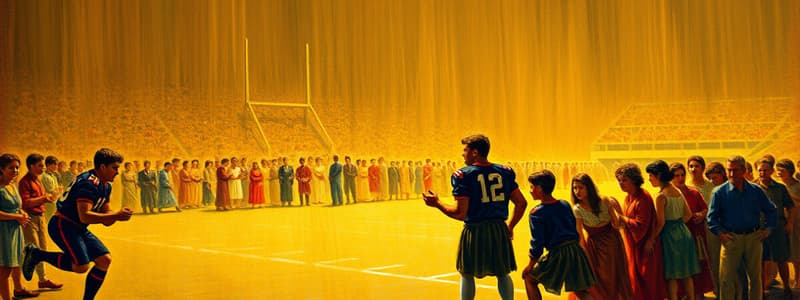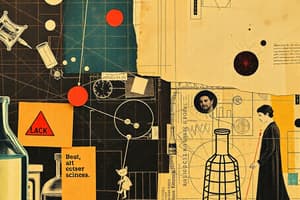Podcast
Questions and Answers
What is the primary reason given for the individual differences among players on a football team?
What is the primary reason given for the individual differences among players on a football team?
- They each have unique playing styles.
- They are from different teams.
- They play different positions.
- Their heights and weights vary. (correct)
What fundamental idea about atoms did John Dalton propose?
What fundamental idea about atoms did John Dalton propose?
- Atoms contain neutrons that vary by element.
- Atoms can change into other elements.
- All atoms of an element are identical. (correct)
- All atoms of an element have different masses.
What important discovery did Frederick Soddy contribute to the understanding of isotopes?
What important discovery did Frederick Soddy contribute to the understanding of isotopes?
- Substances with different radioactive properties can be the same element. (correct)
- Atoms of different elements can have the same mass.
- All isotopes have identical numbers of electrons.
- Neutrons are irrelevant to determining atomic mass.
What term did Frederick Soddy coin to describe atoms that have the same atomic number but different mass numbers?
What term did Frederick Soddy coin to describe atoms that have the same atomic number but different mass numbers?
Which of the following correctly describes isotopes of carbon?
Which of the following correctly describes isotopes of carbon?
What is the maximum number of isotopes of carbon that naturally occur?
What is the maximum number of isotopes of carbon that naturally occur?
What essentially differentiates isotopes of a given element from one another?
What essentially differentiates isotopes of a given element from one another?
Why can isotopes be described as having identical outsides but different insides?
Why can isotopes be described as having identical outsides but different insides?
What recognition did Frederick Soddy achieve for his research on isotopes?
What recognition did Frederick Soddy achieve for his research on isotopes?
Which of the following statements about atomic structure is incorrect?
Which of the following statements about atomic structure is incorrect?
The statement that all atoms of an element are identical is accurate according to John Dalton's atomic theory.
The statement that all atoms of an element are identical is accurate according to John Dalton's atomic theory.
Isotopes are atoms that have identical atomic masses but different numbers of protons.
Isotopes are atoms that have identical atomic masses but different numbers of protons.
Carbon naturally occurs in three forms based on the number of neutrons it contains.
Carbon naturally occurs in three forms based on the number of neutrons it contains.
Frederick Soddy won the Nobel Prize in Chemistry for his contributions to the understanding of isotopes.
Frederick Soddy won the Nobel Prize in Chemistry for his contributions to the understanding of isotopes.
The carbon-14 isotope contains six neutrons.
The carbon-14 isotope contains six neutrons.
Isotopes of an element can have the same mass number if they also have the same number of protons.
Isotopes of an element can have the same mass number if they also have the same number of protons.
The term 'isotope' is derived from Greek words meaning 'equal place'.
The term 'isotope' is derived from Greek words meaning 'equal place'.
The tight end in a football team is expected to be the heaviest player on the team.
The tight end in a football team is expected to be the heaviest player on the team.
All players on a football team are expected to have identical physical characteristics.
All players on a football team are expected to have identical physical characteristics.
The atomic number of carbon is six because it has six protons.
The atomic number of carbon is six because it has six protons.
Flashcards are hidden until you start studying
Study Notes
Football Team Analogy
- Members of a football team exhibit individual differences despite being part of the same unit.
- Players have varying body sizes; kickers are typically smaller than quarterbacks.
- Positions like tight end and defensive tackle differ in weight, showcasing variability within the team.
Atomic Theory and Isotopes
- John Dalton's atomic theory (1804) proposed that all atoms of an element are identical, which has been disproven.
- The discovery of the neutron challenged the idea of identical atoms.
- Frederick Soddy's research on radioactive materials revealed that some elements have different isotopes with varying atomic masses.
- The term "isotope" comes from Greek words meaning "equal place," describing atoms that share outer characteristics but differ internally.
Characteristics of Isotopes
- Isotopes of an element have the same atomic number (number of protons) but different mass numbers, due to variations in the number of neutrons.
- Carbon naturally exists as three isotopes: carbon-12 (6 neutrons), carbon-13 (7 neutrons), and carbon-14 (8 neutrons).
- All carbon isotopes maintain an atomic number of 6 and have 6 electrons for electrical neutrality.
Natural Occurrence and Stability
- Most elements consist of a mixture of isotopes; carbon has three natural isotopes.
- Heavier elements can have multiple isotopes; tin has ten stable isotopes, the highest known for any element.
- Isotopes influence atomic mass but do not affect the chemical reactivity of an element.
- Chemical behavior is determined by the number of protons and electrons, leading to identical chemical reactivity in isotopes like carbon-12 and carbon-13.
Football Team Analogy
- Members of a football team exhibit individual differences despite being part of the same unit.
- Players have varying body sizes; kickers are typically smaller than quarterbacks.
- Positions like tight end and defensive tackle differ in weight, showcasing variability within the team.
Atomic Theory and Isotopes
- John Dalton's atomic theory (1804) proposed that all atoms of an element are identical, which has been disproven.
- The discovery of the neutron challenged the idea of identical atoms.
- Frederick Soddy's research on radioactive materials revealed that some elements have different isotopes with varying atomic masses.
- The term "isotope" comes from Greek words meaning "equal place," describing atoms that share outer characteristics but differ internally.
Characteristics of Isotopes
- Isotopes of an element have the same atomic number (number of protons) but different mass numbers, due to variations in the number of neutrons.
- Carbon naturally exists as three isotopes: carbon-12 (6 neutrons), carbon-13 (7 neutrons), and carbon-14 (8 neutrons).
- All carbon isotopes maintain an atomic number of 6 and have 6 electrons for electrical neutrality.
Natural Occurrence and Stability
- Most elements consist of a mixture of isotopes; carbon has three natural isotopes.
- Heavier elements can have multiple isotopes; tin has ten stable isotopes, the highest known for any element.
- Isotopes influence atomic mass but do not affect the chemical reactivity of an element.
- Chemical behavior is determined by the number of protons and electrons, leading to identical chemical reactivity in isotopes like carbon-12 and carbon-13.
Studying That Suits You
Use AI to generate personalized quizzes and flashcards to suit your learning preferences.




